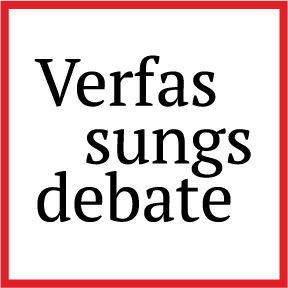Defund Meat: A Call for Transformative Meat Governance
From 15-17 January 2025, the Defund Meat conference was held at the Max Planck Institute for Comparative Public Law and International Law. In the aftermath, the conference speakers jointly issued the Heidelberg Declaration on Transforming Global Meat Governance. This Verfassungsblog symposium features selected conference papers as well as a few additional contributions.
“Defund Meat”: A Sheep in Wolf’s Clothing
“Defund Meat” may be an unusual and perhaps provocative title for a critical interdisciplinary discussion around meat in the Anthropocene. At first blush, it may sound like a crude activist slogan, or a hopelessly idealistic call for abolishing the meat system. Upon closer examination, however, it turns out to be a sheep in wolf’s clothing. As I shall argue, defunding meat is a much more commonsensical, pragmatic, and mainstream(able) proposition than its radical overtone might initially suggest.
To substantiate my claim – and to provide an introductory framing for this symposium – I will advance three theses on meat:
- Current patterns of meat production and consumption have become exceedingly harmful to human, animal, and environmental health, and pose a problem of the magnitude that warrants public intervention.
- The current state of meat governance is paradoxical at best and protectionist at worst, in that it supports unhealthy and unsustainable levels of meat consumption and production.
- We need a new, transformative meat governance to facilitate and accelerate the sustainable food transformation in general and meat system transformation in particular.
The Meat Question: Private or Political?
Thesis 1: The meat problem is a matter of public concern that warrants political intervention.
The meat question – whether, how much, and what kind of meat we want or ought (not) to consume – has long been cast as a private matter. Food is traditionally thought of as a personal choice that may be influenced by ethical, cultural, and religious attitudes, or simply by culinary preferences, but that is ultimately a decision of the consumer alone. At the same time, we can observe an increasing politicization of the meat question. This is because meat is centrally implicated in – and has become a (perhaps the) incarnated symbol of – some of today’s most pressing and interconnected global health and environmental crises.
Overall, there are three important public goods driving the problematization and politicization of meat: human health, animal welfare, and environmental sustainability. In terms of public health, meat is a major driver of global health threats such as the emergence of zoonotic diseases, antimicrobial resistance, and certain diet-related non–communicable diseases (add to that poor labour conditions and environmental harm to local communities). In terms of the suffering and slaughter of (annually more than 80 billion) farmed animals, industrial meat production may very well be – as Yuval Harari puts it – ‘one of the worst crimes in history’. In terms of its environmental impacts, meat is a major driver of climate change (animal agriculture is responsible for 18–20% of anthropogenic GHG emissions), biodiversity loss, deforestation, and (due to its resource inefficiency) amounts to a major form of food loss and carbon opportunity cost.
Meat therefore has massive social costs, and environmental externalities, and profound implications for achieving – or failing – our political commitments and legal obligations towards sustainable development, climate change, public health, biodiversity, and animal welfare. To give just one incisive example: even if all fossil fuel emissions were to be eliminated immediately, global food system emissions alone – of which up to 80% are associated with animal production – could preclude achieving the Paris climate targets of limiting global warming to well below 2°.
Against this backdrop, it is clear that the meat question transcends the private domain and is a legitimate matter of public concern. Indeed, transforming our food system and the meat system in particular is a “wicked problem” that urgently calls for political attention and intervention. It requires governance for the purpose of organizing, through laws and policies, social and economic change towards healthier, more humane and sustainable food systems.
The Status Quo of Meat Governance: Between Paradox and Protectionism
Thesis 2: The current state of meat governance is paradoxical at best and protectionist at worst, in that it continues to support unsustainably high levels of meat consumption and production.
The status quo of meat governance is characterized by a marked contrast between “Is” and “Ought”, and may be best described through the lens of the “meat paradox”. In social psychology, the meat paradox refers to a common form of cognitive dissonance that individuals experience when they engage in a practice (eating meat) that is inconsistent with their values or attitudes: “Most people care about animals and do not want to see them harmed but engage in a diet that requires them to be killed and, usually, to suffer”. This manifests also in a supra-individual ambivalence vis-à-vis the meat question. Call it our collective meat paradox: a societal dissonance between awareness of (and a desire to minimize) the multi-dimensional harms of meat on the one hand, and on the other hand an unabated continuation and consolidation of this exceedingly harmful system of intensive and excessive meat production and consumption.
On the one hand, there is a growing scientific consensus (see e.g., here, here, here, and here) that significant reductions of meat consumption and production and dietary change to more plant-based foods are urgently needed (at least in high– and many middle-income countries). Based on this clear scientific evidence, there is also growing political recognition of the need for a sustainable food transformation as a pivotal mitigation strategy for a variety of global health and environmental challenges. This is reflected in the reports of high-level bodies and international organizations, such as the FAO, the OECD, the World Bank, the WHO, among many others (though it is striking that political and politicized scientific bodies will often omit explicit references to meat reduction and use coded language such as “shifting to healthy sustainable diets” [UNEP Emissions Gap Report] or “Balanced and sustainable healthy diets” [IPCC AR6 Synthesis Report; a direct mention of the negative impacts of meat, of the need for meat reductions, and for of a shifting to more plant-based diets was apparently removed from the report due to political pressure]). For example, the EU Farm to Fork Strategy (a centre piece of the European Green Deal) recognizes the need for sustainable food transformation, for reducing animal proteins, and for shifting to more plant-based diets.
On the other hand, and with a few exceptions (e.g., Denmark’s Action Plan for Plant-based Foods), such political commitments to sustainable food transformation have thus far not translated to any tangible meat reduction (or other transformative food) policies. Moreover, compared to other industries, the livestock sector remains underregulated in terms of its environmental externalities (expressive of a pervasive “agricultural exceptionalism”). Notably, agriculture in general and animal agriculture in particular remain a blind spot in climate mitigation policies and are largely exempt from binding GHG emission reduction targets. There are many reasons for political inaction and inertia towards the meat problem, and there is an “extensive list of potential political barriers” that work to “lock the food system in its current unsustainable trajectory”. For one thing, although meat reduction policies are scientifically necessary, they may meet strong societal and ideological (e.g., “carnism”) resistance and clash with consumer or economic rights. Politicians may therefore consider meat reduction policies “politically toxic” and remain inactive over fear of voter backlash. Another key factor militating against food system change are the vested interests of Big Food, and of Big Meat (the “meat-industrial complex”) in particular. There is strong evidence that the meat industry – much like other politically powerful actors such as the tobacco and fossil fuel industriesy – has obstructed (and misled) public discourse on the negative impacts of meat and is engaged in lobbying and other tactics to influence (or stifle) public policies aimed at addressing these externalities (see e.g., here, here, here, and here).
Moreover, current meat governance is not only not conducive to achieving meat reductions and shifts to more plant-based diets;, on the contrary: it is set up in a way that actively supports high levels of meat production and consumption, reinforcing the primacy of meat within an unsustainable (carnocentric) food system. Put differently, current laws and policies perpetuate a kind of “meat protectionism” that privileges animal foods over plant-based alternatives. Examples of regulatory protectionism include populist bans on cultured meat (e.g., in Italy and Florida); (attempted) bans on using “meaty” labels for plant-based proteins (e.g., in France – struck down by the ECJ; in Switzerland – upheld by the Federal Supreme Court); and prohibitions against using milk-derivative designations for plant-based milk products (based on EU Regulation No 1308/2013, confirmed in ECJ TofuTown). Financial protectionism comes, most notably, in the form of agricultural subsidies. Agriculture is the second largest beneficiary of environmentally harmful subsidies, almost on par with the fossil fuel industry (bizarrely, a reverse polluter-pays situation, in which governments pay the polluters). According to the FAO, global support to agricultural producers amounts to almost USD 540 billion a year, most of which is given to emission-intensive products such as beef and milk. 82% of the EU’s agricultural subsidies support emission-intensive animal products. (Conservative) estimations of Germany’s environmentally harmful subsidies to animal agriculture range from over EUR 5 billion (through reduced VAT on animal products alone) to over EUR 13 billion a year. In Switzerland, around 82% of agricultural subsidies support animal agriculture, accounting for CHF 2.3 billion a year. Apart from direct subsidies, the meat industry also benefits from indirect subsidies in the form of non-internalized externalities – hidden costs that are borne by the public, animals, and the environment (the FAO estimates that global agrifood systems entail staggering hidden costs of at least USD 10.8 trillion annually – excluding the massive but hard-to-measure animal welfare externalities). And as a side note, the world’s biggest industrial livestock companies also receive an average of USD 77 billion per year in private funding on top of (direct and indirect) public support.
This goes to show that governments already intervene in multiple ways to influence meat production and consumption. Put differently, we already have meat governance, albeit a protectionist or meat-enabling one. What we need, going forward, is a new kind of meat governance – a meat-reducing governance – that is better aligned with public health, animal welfare, and environmental sustainability.
Transformative Meat Governance: Elements and Instruments
Thesis 3: We need a new, transformative meat governance that works, through a comprehensive mix of soft and hard instruments, to facilitate and accelerate the sustainable food transformation in general and meat system transformation in particular.
Meat system transformation also requires transforming global meat governance. In thinking about the shape of a new, transformative meat governance (TMG), a couple of crucial points come to mind.
First, TMG should be centrally based on the concept of One Health, and promote its interdependent dimensions of human, animal, and planetary health. The WHO expresses such a One Health approach to the food system when emphasizing that we need to “place health (of people, the planet and animals) at the heart of a transformation” and “transform our food systems to better health and well-being of our planet and all its inhabitants”. Second, the formative purpose of TMG is meat system transformation as part of the sustainable food transformation. In pursuing this overarching goal, TMG needs to foster dietary shifts towards more plant-based foods and, furthermore, account for global food security and a just transition. Third, TMG must strive to minimize as much as possible the food system’s externalities, and to achieve true cost pricing by requiring producers to internalize all remaining externalities into market prices (thus reinstating the polluter-pays principle).
Fourth, any credible TMG must set (progressively more) ambitious targets for reducing meat consumption and production. The immediate goal should be to reach “Peak Meat”, i.e., the point at which consumption of conventional animal proteins decreases. The intermediate goal, then, is to reduce and replace meat (i.e., less conventional and more alternative, plant-based or cultured meat). While there may be no consensus as to precisely how much – if any – meat should figure as part of a healthy sustainable diet, there is broad agreement that massive reductions are necessary in high- and many middle-income countries. Perhaps the most authoritative scientific statement on this matter is the Planetary Health Diet developed by the EAT Lancet Commission, which recommends no or low meat intake of up to 300 g per week (~ 15.7 kg per year). By contrast, current per capita meat consumption in the EU averages at 67 kg per year – four times higher than recommended – and would need to be reduced by 75% over the next decades. The long-term goal of TMG ought to be to phase out industrial meat production (if for no other reason than “averting disastrous climate change”).
Lastly, to be effective, TMG should employ a comprehensive mix of soft and hard, supply- and demand-side interventions, including behavioural and informational, fiscal and market-based, as well as regulatory and prohibitive instruments. Behavioural measures include educational campaigns, revising national dietary guidelines to reflect healthy and sustainable diets, labelling, and nudging (e.g., default plant-based meals). Fiscal measures include eliminating agricultural subsidies for the livestock sector and repurposing agricultural subsidies to support plant-based food production. Moreover, a “meat tax”, such as an environmental levy (e.g., Denmark’s carbon tax on livestock emissions) or an animal welfare levy on animal products, is widely considered a crucial policy instrument for achieving behavioural change in consumers. Furthermore, public funding for novel food technologies such as plant-based meat alternatives, precision fermentation, and cultured meat – currently 1,200 times smaller than that for animal products in the EU – needs to be increased to unlock “parity” between alternative and animal proteins. Finally, regulatory interventions may include higher animal welfare and environmental standards for animal production, mandatory emission reduction targets for animal agriculture, meat advertising bans, creating a more conducive regulatory environment for alternative proteins, as well as regulating private financial flows to phase out environmentally harmful investments in the livestock sector.
Putting the Money Where the Mouth Is
To conclude: “Defund Meat” – far from radical rhetoric – is simply a call for people and society, organized through politics and law, to put their money where their mouth is. It is the commonsensical idea that we should reduce or eliminate public support for an industry that has become exceedingly harmful and destructive, and design laws and policies that work towards transforming the food system in line with our fundamental commitments to public health, animal welfare, and environmental sustainability.



